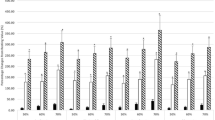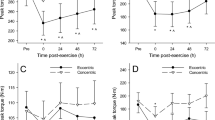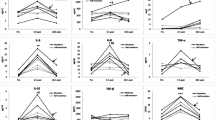Summary
The object of this study was to determine whether leukocytosis would occur in response to eccentric exercise, to concentric exercise, and/or to possible increases in serum corticol levels. Eight men performed 2 bouts of exercise at 46%\(\dot V_{o_{2max} } \) for 40 min. Subjects initially walked up a 10% grade (UW); 2 weeks later they jogged down a 10% grade (DJ), a form of eccentric exercise known to induce delayed onset muscle soreness (DOMS). Venous blood samples were drawn before and after each exercise bout (0, 0.5, 1, 1.5, 2, 2.5, 3, 3.5, 4, and 5 h). Total and differential WBCc and serum cortisol levels were assessed. Results were analyzed using repeated measures ANOVA (2 × 11). Subjects experienced severe DOMS after DJ. There was a significant difference in TWBCc (p<0.0001) between UW and DJ. Post-hoc testing revealed no significant increase over baseline values for UW; after DJ there was a 46% increase over baseline values (p<0.05) initially seen at 1.0 h. These increases in TWBCc were predominantly a reflection of increases in neutrophils which were significant (p<0.0001) when compared to baseline values at 1.0, 1.5 and 2.0 h (∼60%). No significant neutrophil increases were seen after UW. Cortisol levels were similar for both groups pre-exercise (UW=367.1±38.6, DJ=320.2±44.16 mnol · L−1 x±SE) and decreased similarly for both groups after exercise, and thus were not related to the post-exercise neutrophilia. In conclusion, the neutrophilia seen after the DJ appeared to be a response to differences in the exercise, not plasma cortisol levels. Thus a bout of eccentric exercise appears to induce a significant post-exercise increase in neutrophils seen between 1.0 and 2.0 h after the termination of exercise.
Similar content being viewed by others
References
Armstrong RB (1984) Mechanisms of exercise-induced delayed onset muscular soreness: A brief review. Med Sci Sports Exerc 16:529–538
Bobbert MF, Hollander AP, Huijing PA (1986) Factors in delayed onset muscular soreness of man. Med Sci Sports Exerc 18:75–81
Boggs DR, Marsh JC, Chervenick PA, Cartwright GE, Wintrobe MM (1968) Neutrophil releasing activity in plasma of normal human subjects injected with endotoxin. Proc Soc Exp Biol Med 127:689–693
Bruce RA, Kusumi F, Hosmen D (1973) Maximal oxygen intake and nomagraphic assessment of functional aerobic impairment in cardiovascular disease. Am Heart J 85:545–562
Claman HN (1983) Glucocorticosteroids I: anti-inflammatory mechanisms. Hospital Pract: 123–134
Franklin ME, Franklin RC (1988) Plasma volume changes and delayed muscle soreness. Med Sci Sports Exerc [Abstr] 20:75
Friden J, Sjostrom M, Ekblom B (1981) A morphological study of delayed muscle soreness. Experientia 37:506–507
Galbo H (1983) Hormonal and metabolic adaptation to exercise. Georg Thieme Verlag, New York, pp 46–47
Guidelines for exercise testing and prescription. American College of Sports Medicine (1986), 3rd edition. Lea and Febiger, Philadelphia, pp 157–172
Lehninger AL (1982) Principles of Biochemistry, 2nd edition. Worth Publishers, New York, p 724
Ryan GB, Majno G (1977) Acute inflammation. Am J Pathol 86:185–284
Schwane JA, Johnson SR, Vandenakker CB, Armstrong RG (1983) Delayed-onset muscular soreness and plasma CPK and LDH activities after downhill running. Med Sci Sports Exerc 15:51–56
Smith LL, Herbert WG, Hinkle DE (1986) Neutrophilia: a potential sign of inflammation associated with delayed muscle soreness (DMS). Med Sci Sports Exerc [Abstr] 18:43
Tullson PC, Armstrong RB (1978) Exercise-induced muscle inflammation. Fed Proc [Abstr] 2364:663
Author information
Authors and Affiliations
Rights and permissions
About this article
Cite this article
Smith, L.L., McCammon, M., Smith, S. et al. White blood cell response to uphill walking and downhill jogging at similar metabolic loads. Europ. J. Appl. Physiol. 58, 833–837 (1989). https://doi.org/10.1007/BF02332215
Accepted:
Issue Date:
DOI: https://doi.org/10.1007/BF02332215




